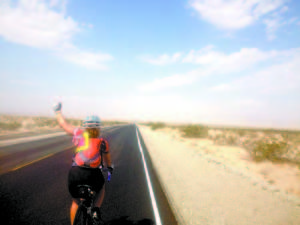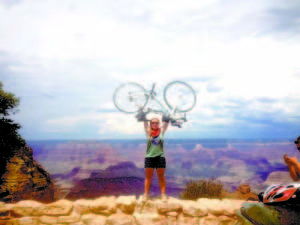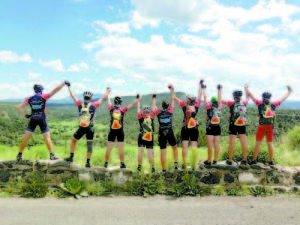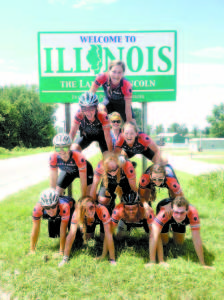Trek was life changing experience

MELISSA PANTER biking through the Mojave Desert on the border of California. The longest ride of 120 miles in one day.
By Wayne E. Rivet
Staff Writer
CASCO — Melissa Panter expected riding a bicycle 3,950 miles across the country would be a life-changing experience.
She saw magnificent sites.
She helped those longing for the American dream — home ownership — by swinging a hammer as part of a construction team.
And ultimately, she landed a “real†job.
The 22-year-old from Casco joined 29 other cyclists from all parts of the country in the “Bike & Build†trek this past summer. Riders left Portland in mid-June and completed their journey in late August in Santa Barbara, Calif. Melissa and her cycling team crossed 12 states, assisted in the construction of several homes, and built a book of memories that will last a lifetime.
“I am most proud that we went 120 miles through the Mojave Desert in one day. That was the coolest thing ever,†she said. “I was the ‘sweep.’ Each day, two or three people are in the back of the group to be sure we don’t lose anyone. I was sweep that day, and was real nervous about it because it was going to be a long day. It turned out to be the best day ever because we had tailwinds, it became overcast so it wasn’t hot (it was supposed to be 110 that day), and we were able to go 30 (mph) because the wind pushed us along.â€
The biggest question mark most riders had going in was whether they had trained enough to keep up a brutal cycling schedule. Raising money for the trip — $4,500 goes to assist housing organizations such as Habitat for Humanity — was time consuming, but working out to reach riding conditioning was challenging. Melissa spent numerous hours cycling up steep hills throughout the Lake Region to prepare for the cross-country journey.
“At the beginning, we were all worried about being sore. After a week and a half, my body finally adjusted to the daily grind. There were some difficult spots, like the Poconos in New York — the hills were intense, but I did it,†Melissa said. “If I or someone else was struggling going up a hill, the others would cheer that person on. Sometimes, we would even bike behind that person, cheering them on. It was awesome.â€
A “conquering†moment was reaching some peaks in the Grand Canyon. After a day or two of climbs, Melissa looked out over the rugged landscape and marveled at its beauty and felt self-gratification, knowing she had put will and physical ability to an ultimate test — and succeeded.
“You felt so accomplished,†she said. “It was grueling. I loved it.â€
The Trek met all of Melissa’s expectations, and beyond.
“It really made a big impact on my life. When I got home (I flew back from the West Coast), I cried because I was no longer riding every day or were with ‘the team.’ I didn’t release how close we became living together all summer long in such a small spaces (be it sleeping at a local church basement or being put up with a local family),†she said. “We apparently lucked out because we were so close. I heard some horror stories about other groups that didn’t get along. We didn’t have any drama. We were in it for the same reason.â€
Along the way, Melissa discovered what “big hearts people have.†Either during work stops to help build a Habitat home or just to rest for the evening, riders received support and encouragement from “strangers we met along the way.â€

One of the three days off during the entire trip was in the Grand Canyon where Melissa biked from the camp site to the ridge to start the hikes and this is the picture to prove it!
Travel was smooth at times, but a little rough in other areas. Some routes changed on the fly due to construction, but cyclists had to maneuver through some bumpy surfaces because “it was the only route.†Safety was always a big concern, especially in the wake of several fatal crashes involving cyclists.
“It changes in every state you are in. In urban areas, especially the East Coast where it seems people are used to seeing cyclists, it was pretty safe. In more rural areas, it seemed people were more aggressive toward us,†Melissa recalled. “We had to be more confident and get out into the road more rather than trying to hug the edge of the pavement. That’s when people seem to try to push you off.â€
The team did encounter a few accidents, but no one was seriously injured. One rider was struck by a car as a woman tried to get ahead of the cyclists to make a turn.
“When you are going down a hill and reaching 40 mph, it’s tough to make a quick stop when a car cuts in front of you,†Melissa said.
The rider was a “little banged up†and took a few days off before climbing back onto the seat and rejoining the group. Melissa also fell victim to road rage in Arizona.
“Arizona was one of the prettiest rides, but had the most hostile drivers. Some people spit at our riders. Some tossed a half a bottle of Sunny D. I guess it was just a mean driver. We were on some flatland and I could see a few miles ahead of me and behind me. There was no one on the road. My friend and I were riding side-by-side, on the other side of the rumble strip (not even on the travel lane), when a car comes up and tries to push us off,†she said. “My friend moved over, and I flew off my bike. I sprained my arm and my left leg was cut up. The car kept going. I was fine. We sat for a half hour. It was the first time that I had fallen. I was a bit jittery at first, but I got back into it. It was an intense situation. It was weird to see how hostile some people can be. I just don’t understand why people would act like that. What are they thinking?â€
Her bike sustained minor damage.

An epic vista viewing and photo shoot. "This picture does not do the scenery justice," Melissa said.
“That bothered me more than the injuries I had,†she said.
But, the number of rude motorists were few considering the number of trucks, cars and motorcycles that passed the cyclists over the nearly 4,000 mile stretch.
“There were so many nice people. At stops, some people gave us donations, while others were really interested in what we were doing,†she said.
Construction was Part 2 of the ride.
“I’ve learned so much about building. I can put in windows now. I can put up siding, walls and roofing,†she said. “I did a lot of painting. My parents already are talking about me putting an addition onto their house.â€
Demolition work was “fun.†She loves to use power tools.
“Most of our work sites were Habitat homes. The families were amazing. Their stories were heartwarming. They were so appreciative,†she said.
One story that touched Melissa was that of a woman caring for a disabled child. The crew was busy clearing the future house lot when Melissa met the soon-to-be owner.
“It was amazing all the troubles and obstacles she has had to overcome,†she said. “It was really inspiring. I loved it.â€
The adventure truly changed Melissa.
“I am more comfortable with myself. I’m more assertive regarding what I need and what I want,†she said. “We did a lot of presentations, so I am better at public speaking. I’m just more comfortable with people, now.â€
The Trek certainly was full of unexpected twists and turns. Habitat for Humanity sent out a newsletter regarding the group’s stopping points, seeking places for riders to sleep and eat. Many times, riders were hosted by church groups.
“We looked forward to the church suppers,†Melissa said. “After a long ride, we were starving. It was nice to have a warm meal.â€
Out of the blue came an offer from a Buddhist retreat center in Cottonwood, Ariz. — located in the “middle of nowhere, nine miles a dirt road,†Melissa said.
“We each had full-size beds to ourselves and bathrooms. It was so nice,†she said. “When my head hit the pillow, I was out.â€
Cyclists learned about meditation.
The Trek also landed Melissa a “real job.â€
Melissa became very good friends with one rider, whom she is now rooming with in North Reading, Mass. And, another friend helped open a door to a job opportunity with Americorps in Salem, Mass.
“When you are pedaling for miles, you talk about your life. One of my friends talked about her job in Salem, Massachusetts. She thought they had a position opening,†Melissa recalled. “In August, she told me it was officially open, so I applied. I had a few interviews over the phone. My second interview was during one of our work days in Arizona.â€
Melissa will be working with a “Youth Build†program, which targets “at risk†youngsters. She will help teach them construction skills, as well as other life skills.
“You never know how your life can change based on one experience,†Melissa said.


